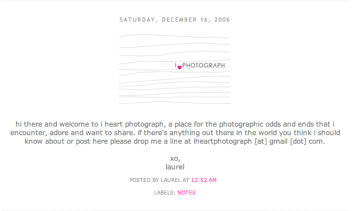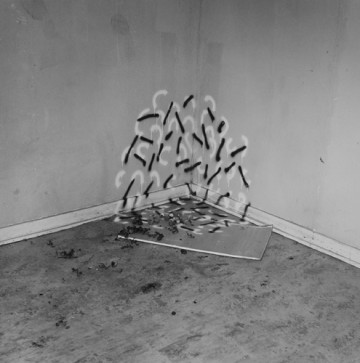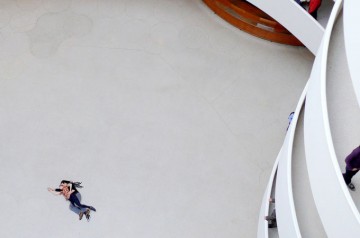
iheartphotograph, screenshot, December 16, 2006
I met Laurel Ptak three years ago back when she was coordinating Aperture’s educational programming and I was their intern terrible. Running into her a few weeks ago in one of those typical everyone knows everyone New York moments, I thought I’d catch up with her as she puts the finishing touches on her MA in Curatorial Studies from Bard about her blog I Heart Photograph. Launched in late 2006, and one of New York’s first blogs to showcase young artists’ hybridizing excavation of photography’s borders, I Heart Photograph has morphed into a venerable index of young photographers and their websites. But within minutes of chatting we were off questioning the methodological means of historicizing art which doesn’t fit into art history’s 30-year rule, and the ways in which we can begin borrowing lessons from curating and digital networks to pursue new means of historiographic argumentation. And while our trail of thoughts poses more questions than answers, it’s one of those conversations that forgoes the pop topic hits to conspire on where to go from here.
Alex Freedman: Tell me about iheartphotograph’s beginnings.
Laurel Ptak: It started from a desire to really explore the margins of contemporary photographic practice and take my own stab at re-authoring its discourse. It opened up a space for me to explore questions that I didn’t find good answers to in my “real world” engagement with the medium. What were photographers doing that went unseen on the walls/pages of the normal art channels? How were younger image makers tinkering with the medium in new and unexpected ways? What were photographers producing or thinking about in other parts of the world? I also thought of it as a kind of critical curatorial practice. I appreciated the way that the Internet allowed the distribution of artworks to function outside of more typical market-driven concerns that seem to prevail here in NYC. I had worked in the ‘culture industry’ here for some years and was frustrated with it on a lot of levels. IHP was in some ways my stab at wondering how things could function differently. Could one open up space for images as ideas more than commodities? Could their immateriality complicate how images circulated in other ‘real world’ circumstances?

iheartphogoraph's first post: John Divola, from the "Vandalism Series," 1973-5
AF: In hindsight IHP began at a point of transition. In 2006-07, Blogger joined google and redesigned itself into a format similar to today’s. Digital cameras were becoming ubiquitous consumer items. How did you see that margin lying outside common art discourse, and how did you see digital and young photography circulating then?
LP: For one thing, it might be good to point out that at that moment blogging wasn’t accepted inside art discourse. By now, institutions and the press have accepted bloggers as ‘experts’ in their own right, but back then it felt a bit more like a renegade kind of practice. I appreciated its ‘illegitimacy’ and miss that to some degree. Art was still something that had to circulate in physical space, not in digital space, with the exception of some new media practices. It’s very different just a few years later. The kind of work I was showing on the blog was also different than what you could see in galleries or on the pages of art magazines, even though by now its been rather assimilated into those contexts. Just four and a half years since I started this project, and already so much has changed.
AF: I know! I was thinking recently about how awkward it can get explaining to younger Internet artists what art on the Internet looked like when I was in college.
LP: I get invited to speak at a lot of art schools and with undergrads, it’s so interesting how their ideas of digital culture are so different than mine. My generation knew the before and after rather intimately. I think that changes what you value about online content. One thing I often notice is the way that they approach the very idea of an object; it is so much more fluid. Things don’t need to be objects until there is a reason for them to be, and can be constantly changed or evolving. It’s much like taking the ideas that a program like Photoshop presents about the image and bringing those notions into the idea of how an object functions.
AF: I sometimes feel like when I’m looking at Internet art that I am getting a re-education about what is possible because the conventions I learned are already a memory.
LP: I agree completely. How we experience temporality and economies of attention have shifted so much. I’ve been trying to direct these feelings into a productive dimension. For instance, I’m just beginning a research project on cyberfeminism, a 1990s-2000s online largely art-based movement, and to really look at it historically and though the lens of the changes we’re speaking about.
AF: What are some of your initial finds?
LP: I’m just beginning to dive in. But some of the most interesting questions I’ve had to ask so far are how one might reconcile such a utopic moment — these women really felt that technology and online culture might overthrow patriarchy — with the dystopia it’s easy to feel about the Internet today.
AF: I can imagine that is especially so for a lot of female Eastern European artists coming out of ideological fatigue into open networks.
LP: A frequent collaborator of mine, artist Marysia Lewandowska, once explained it the fall of Communism and the rise of the Internet as: “Both of those events introduced the possibility of living without an ideologically centered ruling system. Something that comes with an understanding the freedom a new system promises is how easily it can be abused.” There are also compelling questions about the historiography itself. How one could develop a rigorous, yet imaginative methodology that attends to cyberfeminism’s theoretical and radical contours, while attempting to embody them in precisely its historicization? How does one historicize something that is not very old, but feels also quite far away?
AF: I’m trying to envision what that might entail, and it seems incredibly challenging to explain how those networks operated and the relational state of mind they might have engendered to a public vaguely familiar with anything outside of our current, narrowing digital platforms.
LP: Yes, the networked nature of it precisely demands that we understand how to historicize differently. The way history explains or narrates needs to become more dynamic. More open to multiplicity and simultaneity.
AF: When you say that, do you mean in the written narrative’s process of progression?
LP: Yes, and feeling at odds with things like history’s temporal linearity.
AF: I often wonder how one gets around that idea of temporal linearity, and the ways in which one can write a history which embraces a temporal period as something which possess multiple truths that are often at odds with each other.
LP: But cyberfeminism was also a movement, if we can even call it that, that insisted on not defining or reducing itself on any level. It wanted multiplicities and was open to conflicting dialogues, relations. How can one do those things justice? How can we account for these things?
AF: It’s so tricky, in part because we’re having to learn to write history with a kind of sensitivity to multi-directional narratives, which isn’t possible when one is writing about literally dead entities. Especially for those of us who are interested in not robbing certain works of their radical gesture by archiving them or creating a secured history
LP: Yes! This is a very tricky question for me. How can history and radicality co-exist? I also worry about this question in relationship to a lot of art practices, socially-engaged and political works. How can their eventual histories not flatten their importance and their affect?
AF: When I studied political movements, it always seemed like that was an inevitable outcome of socially engaged work or sentiment. But I have seen post-colonial historical texts which do provide strands ideas of what truth represents, and leave it to the reader to negotiate through them. But the writing is really laborious and blots out mystery.
LP: Say more about that.
AF: The books I’m thinking of are histories of African women under British and French colonialism, and they attempt to comprehensively address body politics in the late-1800s through the 1960s. The scenarios in question are really emotionally charged, and lack concrete evidence except for official colonial and missionary recordings. What’s fascinating about these historical texts is how they creatively mine source materials to pose several notions about what the adoption or a transformation of a given practice might have meant over the course of colonial rule. But in providing a range of possible conclusions, the authors are required to spell everything out in such a literal way that the personal touch or spiritual rationale of action is lost. I think art faces a similar problem in that if we spell out too much about meaning in our historiographic inquiry, it is rendered into another form that is systematized outside of itself.
LP: Interesting. A further concern for me with art is this: political movements aren’t exactly commodifiable in the way art is. How do capitalism’s mechanisms complicate the future life and histories of this kind of work?
AF: I wonder if you’re onto something about the political impetus not being commodifiable the way art is.

Tino Sehgal, "The Kiss," 2010. Photo courtesy of the_june's flickr
LP: Maybe minimalism is an interesting moment in art to think about in this regard. For example, when I go to DIA Beacon and am aware on symbolic and economic levels how valuably this art is treated, it does something to erase the radicality of some of this kind of art’s gestures. I end up only knowing about these radical tenants through reading its history. I personally can’t glean those things at all by looking at the objects. But is that true of all art? Is its so-called ‘radicality’ always confined to its immediate time/context or how it is written about? Maybe someone like Tino Sehgal‘s work already touches this kind of nerve I’m trying to get to here, but [contemporaneously]. Its mix of real social and economic conditions and how it already circulates as sort of capital art. It lives with the contradictions we are speaking about, if not invites them. ‘Contradictions’ is not even the right word; it’s more nuanced than that.
AF: Sehgal’s work is really an innovation in capitalist practice in a way, beyond the shock or stunt-like aspect of it.
LP: It’s like the potential problems of historicization we’ve been speaking about are almost built into it. Part of its mechanisms. And of course it gets very polarized reactions.
AF: Very true. If his work isn’t “handled” properly, if one element — the performative attributes, the money, the ephemeral transitoriness — is removed, the works’ concepts could unravel completely.
LP: Yes. Though he goes to great care to keep them inttact, to keep that tension, I suppose.
AF: Indeed — but how long can that survive?
LP: Maybe tension is a productive word to what we’ve been discussing, though…how to write or build or enact that through history. Maybe that’s part of the question I’m asking.
AF: How to keep the tension alive so that the imagination holding it together doesn’t snap?
LP: Yes, and how to not bottom out its “personal touches or spiritual rationals of action,” as you put it earlier. Maybe the recent interest in affect in art is on to this too. I think affect negotiates tension.
AF: I think so — I wonder if the histories of art in the 1990s and early 2000s that are starting to arise will take on this experiment in narrative building, because of the kind of open-endedness the Internet is teaching us.
LP: Will be interesting to see. I am optimistic. I think we also have to think about dismantling the concept of building arguments we have now.
AF: Yes! A less defensive way of responding to the unraveling of solid fact than what has come out of the posts-era of the early 2000s.
LP: Maybe we should be starting a think tank for a far experimental art history!
AF: I’m really into that — gathering together PhD students, recent grads, etc. to come up with compelling modes.
LP: That would be a worthwhile pursuit. To some extent, I think we are talking about a legacy of postmodernism that it didn’t even anticipate.
AF: Precisely and in part, that our generation was educated under its tutelage.
LP: Completely. But already it doesn’t hold for us, so much has shifted, but the new tools don’t feel quite solidified yet either. I decided to pursue curatorial studies and not art history in some ways to attempt to get out of this bind. Curating strikes me as more generative and invested in creating new models, in rearranging the terms. Maybe I see its potential to help create these ‘new tools’ we might not have yet. I think art itself does this enormously too, of course.
AF: Agreed, and for those of us who are invested precisely in the ways in which curating does formulate new visual tools, there needs to be a way to talk about it without cutting off possible interpretations.
LP: True. So we need to organize a conference…or something. And it has to be initiated by our generation. We have a very different vantage point. I know it is widely felt, these frictions we are talking about, but I see us in a unique position to tackle these things ahead.
AF: Exactly, and there needs to be a stronger bridge between an older generation, ours, and the generation that is coming up in ways of speaking to each other about these issues. Something which melds those concerns before the best of both worlds are lost in time translation.
LP: Agreed. I’d say something like e-flux journal is a step in bridging. It has come to terms with the online in more sophisticated ways than other institutions or publications.
AF: E-flux is a nice model in that regard, especially with its international scope.
LP: I feel optimism in this direction when I read it.
AF: Cheers to optimism and plotting out a conference or a new think tank.




